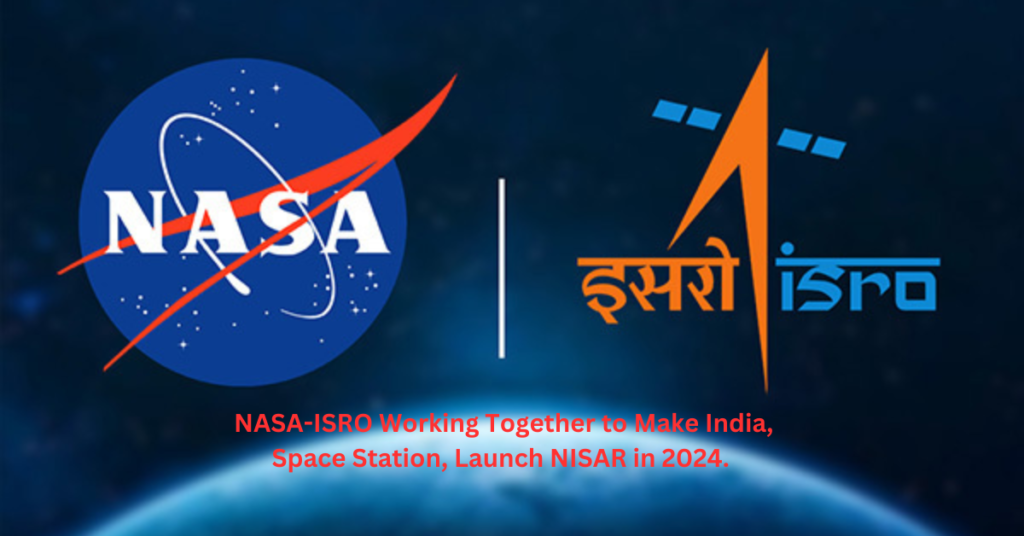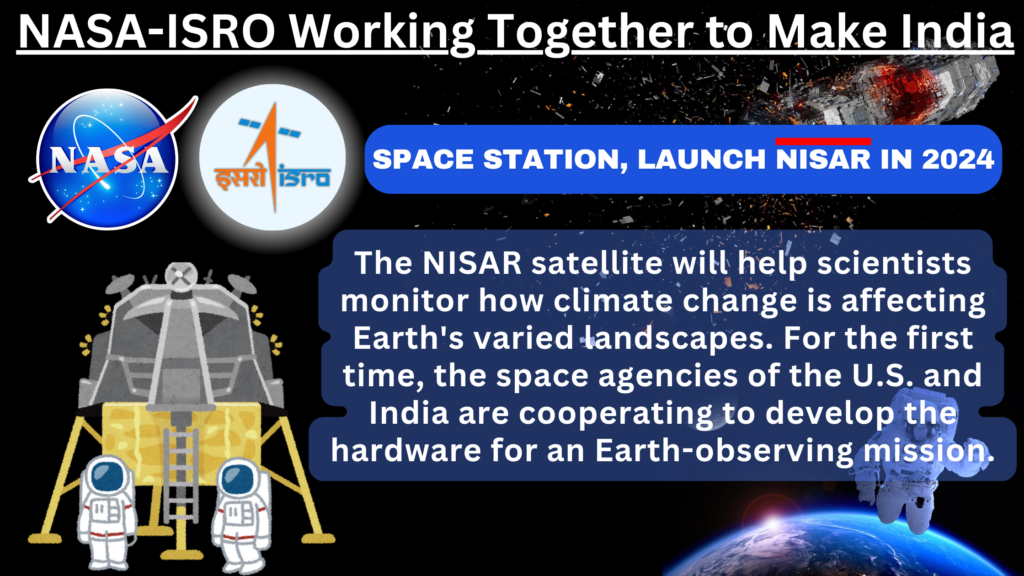
Introduction
The space race has evolved, and now it’s about collaboration rather than competition. NASA and ISRO (Indian Space Research Organisation) are joining forces to push the boundaries of space exploration. This groundbreaking partnership aims to launch the NISAR satellite in 2024 and lay the groundwork for India’s very own space station. This historic collaboration promises to enhance our understanding of Earth and beyond, making significant strides in technology and international relations.
The Significance of NASA-ISRO Collaboration
A New Era of Space Cooperation
In an unprecedented move, NASA and ISRO have combined their expertise and resources to tackle some of the most pressing challenges in space exploration. This collaboration is not just about launching a satellite or building a space station; it’s about fostering a spirit of international cooperation that could set the stage for future joint missions.
NISAR: A Game Changer
NISAR (NASA-ISRO Synthetic Aperture Radar) is set to be one of the most advanced Earth observation satellites ever built. It will provide critical data on natural disasters, ecosystem disturbances, and climate change. By combining NASA’s and ISRO’s technological capabilities, NISAR aims to offer unparalleled insights into the planet’s natural processes.
Advancing Global Space Science
The collaboration is poised to advance global space science significantly. With NISAR, scientists can monitor the Earth’s surface with greater accuracy than ever before, helping predict and mitigate the effects of natural disasters such as earthquakes, tsunamis, and volcanic eruptions. This data is crucial for governments and organizations worldwide to prepare and respond effectively.

Technological Advancements and Innovations
Cutting-Edge Satellite Technology
NISAR will be equipped with the most sophisticated radar imaging systems. Its dual-frequency radar (L-band and S-band) will allow it to observe and measure changes in the Earth’s surface, even through dense forests and clouds. This technology will provide high-resolution images essential for various applications, from agriculture to urban planning.
The Space Station Initiative
India’s ambition to establish a space station is a bold step towards becoming a significant player in space exploration. This station will serve as a research hub, allowing scientists to conduct experiments in microgravity, which can lead to breakthroughs in materials science, biology, and physics. The collaboration with NASA brings invaluable expertise and technology transfer, accelerating the project’s timeline and success.
Future Predictions and Possibilities
The success of these projects could pave the way for more collaborative efforts in the future. We could see joint missions to the Moon, Mars, and beyond, combining resources and knowledge to achieve what no single nation can accomplish alone. This partnership could also inspire other countries to join the global space community, fostering a new era of international cooperation in space exploration.
Impacts on Different Regions
Benefits for India
For India, this partnership is a significant leap forward. It positions ISRO alongside the world’s leading space agencies, enhancing its reputation and capabilities. The technological advancements and knowledge transfer from NASA will boost India’s space program, enabling it to take on more ambitious projects in the future.
Global Implications
Globally, the collaboration sets a precedent for international partnerships in space exploration. It demonstrates that even in a highly competitive field like space, collaboration can lead to groundbreaking achievements that benefit all of humanity. The data and insights gained from NISAR will be shared with scientists and researchers worldwide, fostering a collaborative approach to solving global challenges.
Regional Cooperation and Development
The success of NASA-ISRO projects could stimulate regional cooperation in space science and technology. Neighboring countries might seek to collaborate with ISRO, leading to a more integrated and cooperative approach to space exploration in Asia. This could also boost regional economies by creating jobs and fostering innovation.
Current Trends and Statistics
Growing International Collaboration
The trend of international collaboration in space exploration is on the rise. According to a report by Space Foundation, over 80 countries are now involved in space activities, with many engaging in international partnerships. The NASA-ISRO collaboration is a testament to this growing trend, highlighting the importance of pooling resources and expertise.
Investment in Space Technology
Investment in space technology is increasing globally. Governments and private companies are pouring billions into space exploration, with the global space economy projected to reach $1 trillion by 2040. The NASA-ISRO partnership is a part of this larger trend, showcasing the potential of collaborative investments to drive innovation and discovery.
Advancements in Satellite Technology
Technological advancements are at the core of modern space exploration. From reusable rockets to advanced satellites like NISAR, technology is evolving rapidly. These advancements are making space missions more cost-effective and efficient, allowing for more frequent and ambitious projects.
Real-World Examples and Case Studies
The Success of Chandrayaan and Mars Orbiter Missions
India’s previous missions, such as Chandrayaan and the Mars Orbiter Mission (Mangalyaan), have been hailed as significant achievements in space exploration. These missions demonstrated ISRO’s capability to undertake complex space projects, earning international acclaim. The NASA-ISRO collaboration on NISAR and the space station builds on this legacy, taking it to new heights.
NASA’s International Collaborations
NASA has a long history of successful international collaborations. For example, the International Space Station (ISS) is a joint project involving NASA, Roscosmos (Russia), ESA (Europe), JAXA (Japan), and CSA (Canada). These collaborations have been instrumental in advancing space science and technology, providing a model for the NASA-ISRO partnership.
The Role of Private Companies
Private companies like SpaceX and Blue Origin are also playing a crucial role in modern space exploration. Their collaboration with space agencies has led to significant advancements, such as reusable rockets and commercial space travel. The involvement of private enterprises in the NASA-ISRO projects could further accelerate technological innovation and reduce costs.
Challenges and Solutions
Technical and Logistical Challenges
One of the primary challenges in the NASA-ISRO collaboration is the integration of different technologies and systems. Ensuring compatibility and seamless operation requires meticulous planning and execution. However, both agencies have extensive experience in handling complex projects, making them well-equipped to tackle these challenges.
Funding and Resource Allocation
Securing adequate funding and resources is another critical challenge. Space projects are expensive, and ensuring sustained financial support is crucial. The collaboration between NASA and ISRO can help mitigate this issue by pooling resources and sharing costs, making the projects more financially viable.
Political and Bureaucratic Hurdles
Navigating the political and bureaucratic landscapes of two different countries can be complex. Differences in regulations, policies, and priorities need to be addressed to ensure smooth collaboration. Strong leadership and clear communication channels can help overcome these hurdles, ensuring the projects stay on track.
Proposed Solutions
- Enhanced Communication: Regular communication and coordination between NASA and ISRO teams can help address technical and logistical challenges.
- Joint Funding Initiatives: Collaborative funding initiatives and shared investment strategies can ensure sustained financial support.
- Policy Alignment: Aligning policies and regulations through bilateral agreements can streamline collaboration and reduce bureaucratic hurdles.
Conclusion and Call to Action
The NASA-ISRO collaboration represents a significant milestone in international space exploration. By working together, these two leading space agencies are set to achieve remarkable feats, from launching the advanced NISAR satellite to establishing India’s space station. This partnership not only advances space science but also fosters a spirit of global cooperation, paving the way for future joint missions.
As we look to the future, the success of these projects depends on continued support and collaboration. Governments, private companies, and international organizations must come together to ensure sustained investment in space exploration. By doing so, we can unlock new discoveries; address global challenges and inspire the next generation of scientists and explorers.
Engage with Us
What are your thoughts on the NASA-ISRO collaboration? How do you think it will impact the future of space exploration? Share your opinions in the comments below and join the conversation. Don’t forget to share this article with your friends and colleagues to spread the word about this exciting partnership.
External Resources
- NASA Official Website
- ISRO Official Website
- Space Foundation Report on International Collaboration
- Global Space Economy Projections





